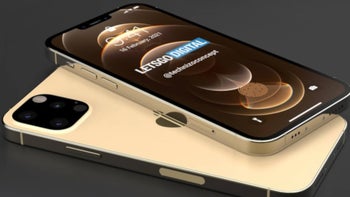Dummy model of 5G Apple iPhone 13 Pro reveals new notch design (VIDEO)

Almost two weeks ago, we showed you glass panels allegedly belonging to the iPhone 13 series. The notch on all three panels is smaller than the notch that has been used on the iPhone since 2017's iPhone X. The three panels weigh in at 5.4-inches (for the iPhone 13 mini), 6.1-inches (for the iPhone 13 and iPhone 13 Pro), and 6.7-inches (for the iPhone 13 Pro Max).
Apple iPhone 13 Dummy model reveals some information about the notch
According to Japan's Macotakara (via 9to5Mac), the notch on the iPhone 13 Pro is 5.35mm in height and 26.8mm in width compared to the 5.3mm in height and 34.83mm width on the iPhone 12 Pro. Based on those dimensions, the iPhone 13 Pro will have a slightly taller notch albeit one that is less wide that the current design. The reason for the change is reportedly due to Apple's decision to move the earpiece speaker to the top bezel.

Another change could be coming to the front-facing camera. Currently positioned on the right side of the notch, the camera might be moved to the left side of the notch on the iPhone 13 series. The dimensions for the dummy unit might have come from supply chain sources. Manufacturers of accessories such as cases receive this schematics well in advance so that these companies can plan the production of cases and screen protectors.
The screen sizes for the iPhone 13 line should match those of the iPhone 12 with a 5.4-inch iPhone 12 mini, a 6.1-inch iPhone 13, a 6.1-inch iPhone 13 Pro and a 6.7-inch iPhone 13 Pro Max. We might see 120Hz ProMotion rapid refresh on the Pro models which are rumored to have an LTPO screen. This would allow for a variable refresh rate so that content that wouldn't benefit from the faster rate wouldn't get it. For example, while animation on a video game would probably take advantage of the screen updating 120 times per second, email or a text might not. As a result, to save battery life, the refresh rate would drop significantly when static content appears on the display.


All four iPhone 13 models will be powered by the 5nm A15 Bionic chipset. The ultra-wide camera on all of the models is expected to feature an aperture of f/1.8 compared to f/2.4 on the iPhone 12 line. Respected analyst Ming-Chi-Kuo says that Apple has freed up some more internal space inside the iPhone 13 so that larger capacity batteries can be used. The combination of 5G and Rapid Refresh capabilities are sure to increase the demand on the batteries for the iPhone 13 series.
Reportedly, Apple will be replacing the magnets used for its MagSafe accessories with slightly stronger ones that might do a better job keeping the accessory connected to the handset. Back in February, supply chain rumors called for Apple to offer a 1TB storage option for the iPhone; that would be the first time that Apple's smartphone offered that much storage to users. And we don't want to forget about the possibility that Apple might include an in-display version of Touch ID which would placate those who would rather verify their identity using their fingerprints.
There might not be any change as far as 5G connectivity is concerned. With the iPhone 12 series, Apple gave all four models the ability to connect with both sub-6GHz and mmWave signals. That includes the low-band signals that travel farther but deliver slower speeds, and the harder to find mmWave signals that feature the fastest 5G speeds in the states.
Once again, we expect Apple to introduce the iPhone 13 series this coming September. Most likely Apple won't have to delay the release of these models like it had to do last year because of the pandemic.










Things that are NOT allowed: